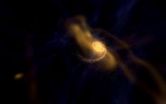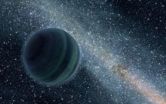(Press-News.org) A Biomedical Engineering Senior Design team at Stevens Institute of Technology is working with the U.S. Army and New Jersey physicians to develop a new device to combat hypothermia among wounded soldiers.
Team "Heat Wave" is composed of seniors Walter Galvez, Amanda Mendez, Geoffrey Ng, and Dalia Shendi, in addition to Biomedical Engineering graduate student Maia Hadidi. The team's faculty advisor is Dr. Vikki Hazelwood and consulting physician is Dr. Herman Morchel from Hackensack University Medical Center. Additional expert support from industry and military was provided by Jan Skadberg, RN, Colonel Boots Hodges, Stevens Burrows, and Major Jim Fulton.
"Stevens unique Senior Design approach gave students real-world experience developing a practical technology in collaboration with the military," says Dr. Hazelwood. "This is a fantastic project with a life-saving application as well as entrepreneurial potential."
Developing a portable device to re-warm patients suffering from hypothermia has the potential to substantially impact battlefield medicine. Loss of blood after trauma is the number one cause of combat fatalities in the United States armed forces. Hypothermia complications associated with loss of blood are shown to reduce the rate of survival after severe trauma by 22.5%.
"Current methods for fighting hypothermia in combat zones are to use an IV drip and wool blanket," says Geoffrey. "With these means it takes up to 16 hours to increase the core body temperature to a more stable point."
The Heat Wave system uses heated, humidified air delivered through an oxygen mask to capitalize on the patient's respiratory system. Capitalizing on the fact that the entire blood volume passes through the lungs, this heat is rapidly transferred to the blood via convection. Tests of their system show it is more effective than current treatments.
"We can decrease the time needed to resuscitate a hypothermic patient to just four hours, a 75% reduction in treatment time," reports Maia. "Not only does this increase survival rates for the patient, but it also frees up field medics so they can attend to others."
The team developed a prototype to test their concept. A heater/humidifier pumps air into an insulated container simulating the lungs, which is connected to an additional container representing the cardiovascular system. Heat transfers between the containers via a water-filled tube to simulate convection between lungs and blood. Heat and humidity are continually recorded via sensors wired to a laptop computer.
"The hands-on Senior Design process is very helpful," Dalia says. "Before Stevens, I had little real experience, and now I know I can research a problem, look at the market for a product, and build and test a successful prototype."
In addition to presenting their research at Senior Projects Expo April 27, the team is participating in the Student Elevator Pitch competition during Research and Entrepreneurship Day on April 29.
"Now that we have proof of concept, we want to pass this idea to someone who can make it into a portable device viable for field treatment," Amanda says.
"Not only is it a life-saving product, but it also has great market potential," says Geoffrey, who is representing the team for the elevator pitch. "The Heat Wave system does not replace current treatments, but is used in parallel, so it has no direct competition."
The students report tremendous satisfaction knowing that their invention will save lives. Contributions like this are a constant fixture for biomedical engineers, a fact that has helped make careers in Biomedical Engineering one of the top-rated in the United States.
"We all felt that this project offered us a unique opportunity," Walter recalls. "We were able to collaborate with the military to save the lives of our soldiers."
###
About the Department of Chemistry, Chemical Biology and Biomedical Engineering
The mission of the Department of Chemistry, Chemical Biology, and Biomedical Engineering (CCBBME) is to exploit the natural interdependence of science and engineering, to maintain comprehensive educational programs, and to conduct innovative and purposeful chemistry and biology research that will both inform and be informed by biomedical engineering applications. CCBBME fulfills the larger mission of Stevens Institute of Technology, which creates new knowledge and educates and inspires students to acquire the competencies needed to lead in scientific discovery and in the creation, application and management of technology to solve complex problems and to build new enterprises.
END
Every year, the world consumes 15 Terrawatts of power. Since the amount of annual harvestable solar energy has been estimated at 50 Terrawatts, students at Stevens Institute of Technology are working on a supercapacitor that will allow us to harness more of this renewable energy through biochar electrodes for supercapacitors, resulting in a cleaner, greener planet.
Supercapacitors are common today in solar panels and hydrogen fuel cell car batteries, but the material they use to store energy, activated carbon, is unsustainable and expensive. Biochar, on the other hand, ...
High-temperature superconductivity can be looked at as a fight for survival at the atomic scale. In an effort to reach that point where electrons pair up and resistance is reduced to zero, superconductivity must compete with numerous, seemingly rival phases of matter.
Understanding those phases and whether or not they are rivals or complementary phenomena has consumed the attention of theoreticians and experimentalists in the quest to find superconducting materials capable of functioning at close-to-room temperature, a potential that has gone unrealized for nearly three ...
When taxpayers underreport income, whether intentionally or accidentally, the IRS always catches up. And when they do, they want to get paid - and now.
Sandra (Delevan, NY) found herself in just this predicament when she came into the Blue Tax offices with an IRS tax liability of $3,636 due to a 2006 tax return filed with underreported income. The goal of the team at Blue Tax was getting this client on a payment arrangement that accurately reflected her income, resolving all of this in a timely manner.
First, Blue Tax met with the client and submitted their personal ...
Mummies from along the Nile are revealing how age-old irrigation techniques may have boosted the plague of schistosomiasis, a water-borne parasitic disease that infects an estimated 200 million people today.
An analysis of the mummies from Nubia, a former kingdom that was located in present-day Sudan, provides details for the first time about the prevalence of the disease across populations in ancient times, and how human alteration of the environment during that era may have contributed to its spread.
The American Journal of Physical Anthropology is publishing the ...
Boston, MA - Charles J. Dimitroff, MS, PhD and colleagues in the Dimitroff Lab at Brigham and Women's Hospital, have developed a fluorinated analog of glucosamine, which, in a recent study, has been shown to block the synthesis of key carbohydrate structures linked to skin inflammation and cancer progression. These findings appear in the April 14, 2011, issue of the Journal of Biological Chemistry.
Dr. Dimitroff and colleagues show for the first time that the fluorinated glucosamine therapeutic works not through direct incorporation into growing sugar chains as previously ...
CHAPEL HILL, N.C. – A team of researchers, including a number from the University of North Carolina at Chapel Hill School of Medicine, have pinpointed regions of the genome that contribute to the debilitating lung disease that is the hallmark of cystic fibrosis.
Their findings provide insight into the causes of the wide variation in lung disease severity experienced by CF patients. It also points the way to new diagnostic markers and therapeutic approaches for this and more common lung diseases such as COPD.
This study, which appears online Sunday, May 22, 2011 in ...
Quit Tea, the natural stop smoking aid, has received an official professional endorsement. "This is a good product I will continue to tell my clients about," says Leeanne Taylor, a licensed drug and alcohol counselor with a private practice in Bangor, Maine, who specializes in smoking cessation.
Ms. Taylor received free samples of Quit Tea as part of the Quit Tea LLC's local Maine smoking cessation professional detailing program. She said "since that time I have given clients a tea bag and the website so they could get some of their own. The majority of ...
How unique is the Milky Way?
To find out, a group of researchers led by Stanford University astrophysicist Risa Wechsler compared the Milky Way to similar galaxies and found that just four percent are like the galaxy Earth calls home.
"We are interested in how the Milky Way fits into the broader context of the universe", said Wechsler. "This research helps us understand whether our galaxy is typical or not, and may provide clues to its formation history."
The research team compared the Milky Way to similar galaxies in terms of luminosity--a measure of how much light ...
Freelance writer Robert Brault offers a metaphor for the night sky, "A trillion asterisks and no explanations." By supporting astronomers, the National Science Foundation (NSF) helps to provide explanations. A recent NSF- and NASA-funded study provides one more explanation.
Astronomers have discovered a new population of Jupiter-size planets floating alone in the dark of space, away from the light of a star. According to the scientists, these lone worlds were probably ejected from developing planetary systems.
The discovery is based on a joint Japan-New Zealand survey, ...
Researchers from Mount Sinai School of Medicine have discovered a protein signaling pathway that becomes hyperactivated in human sarcoma cells, suggesting that medications to inhibit this pathway may be effective in the treatment of human sarcomas. The research is published in the current issue of the journal Cancer Cell.
A team of researchers led by Stuart Aaronson, MD, Jack and Jane B. Aron Professor and Chairman of the Department of Oncological Sciences at Mount Sinai School of Medicine, compared normal human mesenchymal stem cells to human sarcoma cells and found ...


